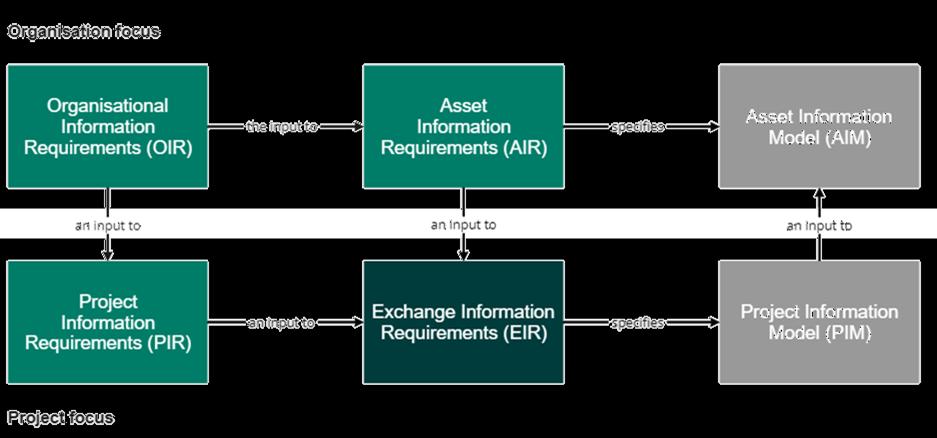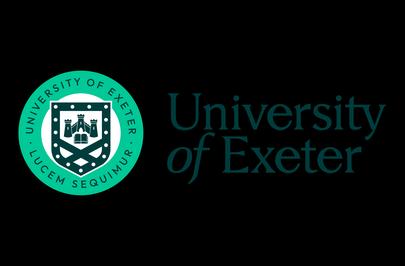
Estates Department



Estates Department

Introduction
The University of Exeter is implementing Information Management through Building Information Modelling (BIM) to enhance project delivery and asset management within their capital development program. This Organisational Information Requirements (OIR) document outlines the information necessary to meet the University’s high-level strategic objectives. As illustrated in the figure below, the University’s vision defines key activities for managing their built asset portfolio. The OIR details the relevant, and meaningful information required by the University to achieve strategic outcome targets for these activities.
Information management structure and responsibilities:
Accurate, consistent and integrated data on all aspects of the estate is required by the following teams across the organisation:
Within Estates Within the wider organisation
• Direct Works
• Engineering
• Capital Development
• Built Environment
• Strategic Space
• Infrastructure
Organisational Vision

Project management
Asset operation or utilisation
Quality management
Sustainability and decarbonisation
Organisational Information Requirements (OIR)

• Sustainability
• Finance
• Health, Safety and Environmental
• Faculties
• Digital and IT
• Business Intelligence Teams who provide planning and management information for Senior leadership team including Vice-Chancellor and Chief Executive

Define information needed for strategic decisions.

Define information needed for strategic activities.
• Education and Academic Services who timetable space and ensure the student experience remains exceptional. They also support accessibility and wellbeing.
• Facilities Management
• Legal and Procurement
Organizations need to identify the information required for asset use and operation before focusing on project delivery needs. Understanding the necessary information throughout an asset’s lifecycle enables the University of Exeter to function effectively. The OIR is designed to clarify the University’s highlevel information needs, aiding the Appointing Party and their Information Manager in drafting the Project Information Requirements (PIR) and Exchange Information Requirements (EIR). This ensures that accurate information is gathered and relayed back to the University, supporting strategic activities and decisions.
This document does not seek to directly answer all information required to deliver projects and manage assets. It aims to serve as an internal high level strategic document.
This OIR document informs both the PIR and Asset Information Requirements (AIR) which may be configured to an individual project. In turn the PIR and AIR act to influence the project’s contractual EIR, which are responded to by the Delivery Team through production of the Project Information Model (PIM) and subsequently the Asset Information Model (AIM) which is provided back to University of Exeter.
The University of Exeter is committed to ensuring that our estate operations are aligned with our strategic vision to support a greener, fairer, and healthier world while developing campuses that fosters learning, collaboration, and well-being. Efficient building management directly impacts the comfort, safety, and overall experience of our staff and students. To achieve this, we recognise the critical
importance of collecting and managing building information in a structured, consistent, and compliant manner.
The University of Exeter has ambitious plans and expectations outlined in its 2030 Strategy. To support the development of these ideas, UoE must provide essential Estates services. These services need to be delivered and assured at a level of maturity necessary to achieve the University’s 2030 ambitions. The Organisational Information Requirements will offer a clear, cohesive focus on the visions, aims, and improvement actions required for Estates services to meet these goals.
‘Drive operational excellence and accelerate our journey towards net zero by leveraging the opportunity of aligned, transparent and accessible data. We aim to create a digitally connected campus to enhances both research capabilities and the staff and student experience.’
This vision aligns with Strategy 2030 key focus areas of being Fair, Green and Just. Supporting people, place and partnerships. UoE Estates team have agreed on 6 strategic pillars to support it’s growth and development plans.


•Ensuring consistency to enable integration through processes, data collection, and management practices that are unified across the estate. By Leveraging the opportunity of transparent and accessible data we aim to reduce duplication and inconsistencies
•By aligning with ISO 19650 and other relevant standards, we ensure that we meet legal, health and safety, and environmental regulations.


•Our commitment to reaching net zero emissions necessitates the efficient management of energy consumption, waste reduction, and sustainable building practices through the use of precise data.
















•Achieve Operational Efficiency through the collection of accurate, up-to-date building information which enables us to streamline maintenance, reduce operational costs, and optimise the use of our resources.
•We aim to leverage integrated technology and advanced analytics to foster a SMART, data-driven environment, which supports research initiatives and continuous innovation across the estate. Our approach is designed to evolve and develop to remain relevant and continually advance.


•We strive to promote collaboration and connection by utilizing integrated technology and advanced analytics to create a SMART, data-driven environment that promotes research initiatives and continuous innovation throughout the estate.


• At the University of Exeter, one of our core stratgic pillars is for information to be seamlessly aligned from capital delivery to operations and consolidated into a single source of truth. This synchronization enables easy access to reliable data, streamlining operations, reducing redundancies, and enhancing overall efficiency.
• Effective information management guarantees that data remains consistently updated, accurate, and accessible within a centralized system. This is crucial for maintaining synchronization across Estates information and systems, facilitating seamless decisionmaking and alignment with strategic objectives


• All operations need to comply with information management standards, university policies (including Environmental, Health and Safety), and regulations. This ensures the university operates within legal frameworks, maintains ethical practices, upholds its reputation, mitigates risks, and fosters stakeholder trust.
• Information management facilitates compliance by ensuring data is handled according to regulatory requirements, securely stored, and readily accessible for audits and reviews. It aids in monitoring and enforcing policy adherence, preventing legal issues, and maintaining a secure operational environment.


• The University of Exeter is dedicated to long-term financial and environmental sustainability, aiming for net-zero carbon by 2030. Smart technologies and efficient resource management are crucial for minimizing environmental impact and ensuring future resilience. Sustainability is vital for the university’s future viability and its positive societal impact.
• Information management underpins sustainability by optimizing data use to inform resource management and environmental impact decisions. It enables accurate tracking of sustainability metrics and facilitates efficient resource use, aligning with the university’s sustainability objectives.
• Sustainability requirements are incorporated into the AIR and PIR.


• Value is generated by maximizing the benefits of systems and digital integration, improving asset performance, and reducing operational costs. This approach enhances efficiency, supports sustainability goals, and ensures the University of Exeter gets the most from its resources, driving both financial savings and high-quality outcomes.
• Information management plays a key role in optimizing asset performance and operational efficiency by providing accurate data for decisionmaking. It supports cost reduction through effective resource management and aligns with sustainability objectives by ensuring data-driven insights into resource use and operational practices.


• Innovation is driven by the integration of digital technologies to enhance capital delivery, operational efficiency, and foster creative solutions. This creates a culture of continuous improvement and technological advancement.
• Information management supports innovation by enabling the seamless adoption of new digital technologies and ensuring effective data management. It plays a crucial role in fostering a culture of innovation by providing the necessary information infrastructure for testing, scaling, and implementing new ideas and technologies.


• University of Exeter community is wellconnected through integrated data and systems, fostering collaboration and enhancing the student experience. A "smart living" campus supports research, well-being, and a vibrant, collaborative environment.
• Information management facilitates connectivity by ensuring that data and systems are integrated and accessible across the university community. It supports the creation of a collaborative environment by enabling smooth data sharing and communication, enhancing both research efforts and the overall users experience.


UK BIM Framework includes the standards, guidance and resources which constitute the overarching approach to information management using BIM in the UK.
BS EN ISO 19650 outlines a clear responsibility for an appointing party such as clients, including public sector organisations, to understand and specify what project and whole-life asset related information they require from the project outset onwards.
This approach is supported by BSI and nima, and is cited in key policy documentation such as the Construction Playbook, Trust and Productivity, and the TIP Roadmap to 2030.
In the context of the ISO 19650 series it is important to understand the Interfaces between parties & teams:
An Appointing Party: Receiver of information concerning works, goods or services from a lead appointed party.
A Lead Appointed Party
Responsible for co-ordinating information between the delivery team that they are a part of and the appointing party (client), fulfilling the role of the ‘lead appointed party’ in the context of the ISO 19650 series. Can be a member of both the Project Team and a Delivery Team.
An Appointed Party
Provider of information concerning works, goods or services.


Building Information Modelling and Management (BIM) enables the accurate transfer of information throughout projects lifecycle and supports to:
Design – Deploy digital techniques to design better performing buildings, homes and infrastructure. Use good practice, secure by default, information management to get data right from the start.
Build – Exploit new and emerging digital construction and manufacturing technologies, processes and techniques. Secure, shared information, enabling clients, design teams, construction teams and the supply chain to work more closely together to improve safety, quality and productivity during construction.

Operate – Use real time information to transform the performance of the built environment and its social and economic infrastructure. Smart asset management to predict and avoid disruption of services. Digitalisation of existing assets and infrastructure.
Integrate – Understand how spaces and services can improve citizen quality of life. Feed that information in to the design and build of our economic and social infrastructure and the operation and integration of services they deliver.
In 2010, the UK Government set out a vision for building information modelling (BIM) adoption and mandated BIM adoption by April 2016 across construction projects procured by central government departments. Interoperability was part of its vision: “Government as a client can derive significant improvements in cost, value and carbon performance through the use of open shareable asset information.”
For the University of Exeter, Information Management standards provide a clear and standardised process for managing information digitally during the life cycle of a physical asset. Combining the two will help us to achieve higher levels of maturity and to demonstrate our ability to deliver high-quality services that meet customer needs and business objectives. Establishing and maintaining an audit trail of information enables cost savings to be made in the design, build and operate processes, allows information to be accessible, verified, and capable of being relied upon over the lifetime of the asset.
Linked to, and complementing, the ISO 19650 series in the UK is a National Annex providing a UK-specific context. This can best be summarised in the diagram below from ISO 19650 series noting that the OIR is an internal document.

The below table communicate the high-level information management goals, objectives an existing policies that will be obtained through the adoption of ISO 19650 series principles through day-to-day activities in the Estates operations at the University of Exeter.

Health & Safety Management
and implement smart management technologies for efficiency and ease of maintenance.
Improve workplace ecology, understand and manage risks, and achieve compliance for the health, safety, and wellbeing of users and operators.
Planning & Regulatory Compliance
Access information for informed operational insights, future planning, and meeting statutory/regulatory obligations.
Security Management Implement and maintain cyber security best practices, and leverage security practices to reduce adverse impacts and ensure secure environments.
Environmental & Energy Management
Innovation & Technological Advancements
Achieve sustainability goals through energy tracking, environmental compliance, and creating optimal working conditions.
Utilise digital tools and innovations, including IoT and automation, to deliver efficient building design, construction and operations.
Financial & Asset Management
Maintenance & Performance
Monitoring
Enable informed financial decisions, manage assets, and understand liabilities, to achieve strategic objectives and ensure compliance.
Implement live status reporting, schedule maintenance, and improve asset information for preemptive maintenance and quick response to issues.
Space & Material Optimisation
Optimise material usage, understand space utilisation, and gather user feedback for service improvement and reduced waste.
Demand & Experience Management
Stakeholder Engagement & Education
Manage customer expectations, provide seamless experiences, communicate achievements, and reduce reputational risks through security and information dissemination.
Provide a digital workplace, flexibility, and support for performance and learning, while educating stakeholders on sustainability goals.
The University of Exeter will follow the Facilities Management Standard 002: Asset Data of the Government Functional Standard for Property (GovS 004)
The aim of this standard is to improve the quality, consistency, interoperability and usage of facilities management (FM) asset data throughout the government estate.
The key principle that informs this standard is that public sector organisations must be able to produce an asset register of all their FM assets and be aware of the condition and maintenance requirements of each asset.
This standard sets the following minimum requirements:
1 Structure
The requirements for FM asset registers and the parameters of assurance frameworks required to ensure ongoing validation of the data. The aim is to ensure that across public sector organisations there is consistent FM asset data which is kept up to date.
2 Systems
The requirements for ownership and accessibility of FM asset data, along with the minimum requirements to ensure flexibility, interoperability and security of the data. The aim is to ensure that public sector FM asset data is portable between organisations and suppliers.
3 Usage
The requirement that policies and procedures are in place to ensure the application of FM asset data to support decision-making and that facilities managers have the capacity, capability and responsibility to effectively utilise the FM asset data
Details in the Assets Information Requirements (AIR)
The University of Exeter will follow NRM 3: Order of cost estimating and cost planning for building maintenance works. This provides a structured basis for measurement of building maintenance works, encompassing the annualised maintenance and life cycle major repairs and replacements of constructed assets and building components – which are carried out post construction procurement and throughout the in use phases of the constructed assets, or built environment.
The prime function of these rules is to provide consistent rules for the quantification and measurement of building maintenance work items – for the purposes of producing order of cost estimates, elemental cost plans and detailed asset specific work programmes, throughout the entire building life cycle.
• Group element 0: Facilitating works 107
• Group element 1: Substructure 118
• Group element 2: Superstructure 139
• Group element 3: Internal finishes 201
• Group element 4: Fittings, furnishings and equipment 211
• Group element 5: Services 224
• Group element 6: Prefabricated buildings and building units 322
• Group element 7: Work to existing buildings 323
• Group element 8: External works 340
• Group element 9: Maintenance contractor’s management and administration costs
• Group element 10: Maintenance contractor’s overheads and profits 425
• Group element 11: Consultants’ and specialists’ fees 426
• Group element 12: Employer-definable maintenance-related costs 433
• Group element 13: Risks 436 Group element 14: Inflation
The University of Exeter will utilise Autodesk Build as their Common Data Environment.
This AIM CDE will be used for projects under 1 M. For larger project the Appointing party will provide a CDE. UoE Consultants and partner will be assessed to show capabilities of using Autodesk Build.
(Information to be added from Symetri)
The organisational information requirements (OIR) require review annually and governance processes will be implemented to ensure their continual improvement.
Change management processes to align with the Estates internal processes, an annual ‘lessons learnt’ workshop to be held, where the objectives and subsequent policies and requirements are reviewed, updated and improved.
To ensure a holistic and consistent approach is maintained while supporting the continual improvement of information management practices, it is critical to review and update ISO 19650 documentation to reflect evolving operational, regulatory, and technological needs. The QA process to manage the process of updated the document set is outlined below.
Any stakeholder within the University or its partners team can initiate a change request. This request must be submitted via esdigital@exeter.ac.uk for review by the Digital Estates Governance Board, explaining the rationale behind the change, the potential impact on current processes, and any associated risks or benefits.
2 Review and Impact Assessment
The Board will assess the proposed change, taking into account its alignment with the strategic pillars and any potential operational, environmental, regulatory, or financial impacts. The board will make a recommendation for how the change should be adopted.
A successful implementation of the OIR will provide a range of benefits the University, including improved Estates service quality, cost savings, enhanced students' satisfaction, improved collaboration and communication, improved decision-making and the foundation for a SMART and Sustainable campus.
Enhanced Estates Service Quality: Implementing the OIR successfully will enhance the quality and reliability of our services. By aligning these services with customer needs and business goals, and adopting BIM best practices to deliver more efficient, effective, and user-centric services.
Cost Reduction: Effective implementation of the OIR can also result in cost savings. Standardizing processes and eliminating inefficiencies which can lower the costs of delivering our professional services while enhancing their quality and effectiveness.
Increased student Satisfaction: By prioritizing students and staff needs and expectations and providing high-quality Estates services that meet these needs, we can boost student satisfaction and provide the optimum learning environment.
Better Collaboration and Communication: Successful implementation of the OIR will enhance collaboration and communication between Estates services and other university departments. Using a common language and set of concepts will foster greater collaboration and communication, leading to better outcomes for the University of Exeter.




